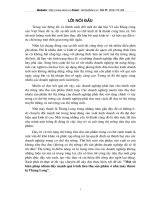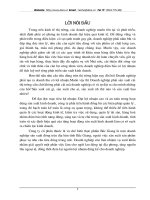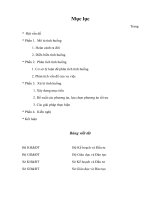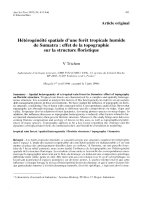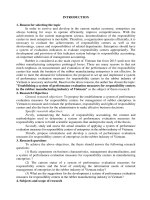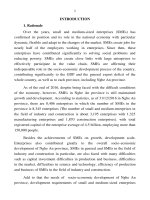- Trang chủ >>
- Thạc sĩ - Cao học >>
- Luật
La dangtaiantrang sum
Bạn đang xem bản rút gọn của tài liệu. Xem và tải ngay bản đầy đủ của tài liệu tại đây (135.33 KB, 8 trang )
1
INTRODUCTION
2
(6) What is the level of impact of short-term and long-term liabilities to total assets ratio on the
performance of listed companies?
1.1. Background and Rationale of the Study
1.3. Scope
The capital structure in the field of corporate finance is a controversial subject in the world, especially
regarding the impact of capital structure on profitability, value or performance of company. In Vietnam the
process of economic transformation since the 1990s bring out requirements for restructuring of State-owned
Enterprises (SOEs) and equitization of SOEs in particular.
The development of listed companies on the stock market in the recent years also raises a hot topic on the
impact of capital structure on the performance of listed companies.
- Research subjects are the capital structure and performance of listed companies, except the listed
companies in the financial and banking, insurance, and property industries on the Vietnam stock market.
- Research scope includes 461 listed companies on the two stock exchanges (i.e. Ho Chi Minh City Stock
Exchange and Hanoi Stock Exchange) from 2008 to 2014.
1.4. Methodologies
In the world there are many articles and research works on the relationship between the capital structure of
The study uses secondary data because the aim is to investigate the impact of capital structure on
the company and the performance of the company, but the research results are inconsistent. In Vietnam, in recent
performance of listed companies on the Vietnam stock market for the period 2008 - 2014. The data was obtained
years there have been studies on the impact of capital structure on the profitability and performance of listed
from the audited annual financial reports of 461 listed companies on the two stock exchanges in Vietnam.
companies. These studies, however, are not comprehensive enough due to inadequate data samples and they do
not take into account the intrinsic characteristics of firms and the macroeconomic environment. It does not
consider indicators such as the market value of firms and the difference in capital structure of enterprises on the
The method of data analysis used in this research is the descriptive, correlation and regression technique.
In order to test the hypotheses concerning the relationship between the dependent and independent variables,
STATA 11 software was used.
HOSE and HNX exchanges. In addition, these studies do not comprehensively take into account the indicators
reflecting the performances of firms so as to further evaluate the impact of capital structure on these indicators
1.5. The new contributions of dissertation
(i.e. by market value and book value). Thus, this comprehensive study in the context of Vietnam will help add
new points in the research and theory of capital structure and performance of firms and policy-making as well.
Based on the capital structure theory of Modigliani and Miller (1958, 1963), the tradeoff theory, the
The findings of the research on this subject also help making macro-policy in Vietnam and figuring out the
agency theory and pecking-order theory, the empirical studies in the world give different results on the impact of
solutions for improving capital structure, enhancing profitability, operation efficiency, and value of companies.
capital structure on the performance of firms. This study adds measures of firm performance based on book
Hence the dissertation “the impact of capital structure on the performance of listed companies on the
Vietnam stock market” would be meaningful in terms of practice and theory as well.
1.2. Objectives
value and market value, considering the difference between short-term debt, long-term debt, long-term
borrowing debt, macroeconomics, industry, firm size in the context of Vietnam. The findings of this study show
that the inconsistencies in studies of capital structure and performance of firms in developed and developing
countries may be due to the intrinsic nature of environment of the enterprise. Therefore, these fundamental
The dissertation aims to review and compare the capital structure theories in order to understand the
theories remain valuable in explaining the relationship between capital structure and the performance of firms.
impact of capital structure on the performance and value of company. From the aspect of empirical study the
However, the analysis and interpretation need to be careful in the specific conditions. The new contributions of
dissertation would analyze the impact of capital structure, short-term and long-term liabilities ratios, on the
the research are as follows:
performance and value of company by using a variety of accounting, economic, and market indicators in the
context of Vietnam.
The dissertation also analyses the other influential factors like growth opportunities, company size, age of
a company, and sectors on the performance and value of company in general.
The key research questions as following:
(1) Does the capital structure impact on the performance of listed companies?
(1) The debt to asset ratio has a negative impact on the performance of companies measured by accounting
indicators (ROE, ROA, GM), but has a positive impact on the firm's market value indicators (MBVE, PB).
(2) The short-term debt to asset ratio negatively impacts ROE and ROA, but the long-term debt to asset
ratio has a positive impact on ROE and negative impact on ROA and ROCE.
(3) The long-term debt to asset ratio has a positive impact on ROE and market value of the firm (PB).
Thus, in the debt structure of companies, the increase of long-term borrowing debt ratio is the most significant in
improving the profitability and value of enterprises, in which the ratio of short-term debt has the most negative
(2) In what way does the capital structure impact on the performance of listed companies in the Vietnam
impact on the performance of companies.
stock market?
(4) The capital structure with high debt ratio in the context of macroeconomic instability will negatively
(3) How does the long-term liabilities to total assets ratio impact on the performance of listed companies?
(4) How does the long-term borrowing to total assets ratio impact on the performance of listed companies?
(5) How does the short-term liabilities to total assets ratio impact on the performance of listed companies?
affect the performance of the companies. Therefore, the determination of capital structure should be set in the
specific context.
3
4
(5) The size of the company has a negative impact on the ROE, ROA, ROCE, and PB indicators showing
CHAPTER 1
a declining profitability and the market underestimates the potential for growth as the size of the company
increases.
LITERATURE REVIEW ON THE IMPACT OF CAPITAL STRUCTURE ON THE PERFORMANCE
OF COMPANIES
(6) The listed companies in the stock exchange with higher listing requirements and better public
ownership will have higher market value.
(7) There are issues of barriers, bottlenecks and macro-environmental issues that would reduce the
performance of the companies when they are expanding.
(8) Macro conditions actually affect the performance of companies.
1.1. Overview of capital structure and performance of the company
1.1.1. Capital source of company
a) Liabilities source
- Commercial credit
- Debt financing from financial institutions: Short-term loans and long-term loans.
- Issuing debt securities: Issuance of short-term debt securities and bonds.
b) Equity: owners’ chattered capital; paid-in capital, capital surplus, retained earnings.
1.1.2. Capital structure
a) Definition of capital structure
Financial or capital structure is the mixture of capital types to finance for the assets of companies. A
rational capital structure, balanced with the asset structure will help the stable operation of a company.
b) Measures of capital structure of enterprises
Debt ratio: Indicating the level of use of corporate loans and the percentage of assets financed by the loan.
The indicators can be measured as follows:
Debt to total assets ratio = Total debt/Total assets
Long-term debt to total assets ratio = Long-term debt/Total assets
Short-term debt to total assets ratio = Short-term debt/Total assets
1.1.3. The measures of performance of enterprises
a) Overview of measurement indicators of performance of enterprises
The indicators of performance of enterprises can be divided into three main categories: accounting
measures, economic measures, and measure of market value.
b) Accounting measures
- Profitability to total assets (ROA)
ROA = Profit after tax / Total assets
- Return on equity (ROE)
ROE = Net profit after tax/ Equity
- Return on capital employed (ROCE)
ROCE = Earnings before tax and interest (EBIT)/Capital employed In which, capital employed = equity +
long-term debt
- Gross margin (GM)
Gross margin = Gross profit/Revenue
c) Market value measures
5
- Market price of a share on earnings per share (P/E)
P/E = The current price of share/earnings per share
- Market price of a share on book value per share (P/B).
P/B = Market price of a share/book value per share
- Market value of equity and book value of liabilities divided by book value of equity (MBVE)
1.2. Capital structure theories
1.2.1. Modigliani and Miller’s capital structure theories (M&M)
Modigliani and Miller theory shows that the choice of capital structure including debt/equity does not
have an impact on corporate value.
It also gives the second premise that the cost of equity increases linearly with leverage, in which it keeps
the weighted average cost of capital unchanged.
1.2.2. Trade-off theory
MM (1963) reviewed and refined the analysis of capital structure with the inclusion of corporate tax and
showed that the capital structure was indeed related to the value of the firm. The most important implication of
trade-off theory is that profitable firms use more debt because they are less likely to go bankrupt and thus benefit
more from the benefits of tax.
However, if the cost of financial distress or bankruptcy costs increases, the borrowing ability of companies
goes down, making it unable to fully utilize the benefits of the tax shield. In other words, optimal capital
structure can not be 100% debt.
1.2.3. Agency theory
There is a conflict of interest between the board of directors, the shareholder and the lender. Agency cost
is defined as the total cost of contract, including management cost, constraints control, and opportunity costs can
occur when there are no conflicts of interest. Agency costs are of no substance to any group. The core of the
theory is the relationship between the board of directors and shareholders and between shareholders and lenders.
These relationships give rise to agency costs. Thus, the company's capital structure policy objective would be to
minimize agency costs to maximize the value of the company.
1.2.4. Pecking-order theory
The empirical implications of the pecking-order theory is that when stocks are released, new investors will
assume that the manager has unfavorable information and thus the stock price will fall. This means that the firm
finances its operations firstly by retained earnings, then the secured debt, unsecured debt, and finally the equity.
1.3. Empirical study on the impact of capital structure on performance of firms
1.3.1. Empirical research in the world
There can be no uniform formula for the optimal capital structure for markets and the impact of capital
structure on the value or performance of a company varies. Thus, the specific impact can only be studied on a
certain circumstance.
6
1.3.2. Empirical research in Vietnam
Empirical research on the impact of capital structure on the performance of companies based on
quantitative models in Vietnam is limited as it does not fully reflect the measures of performance, including
market value, limits in research sample, not covering macroeconomic, industry factors in the model, or
separating the impact of short-term debt and long-term debt ratio.
7
8
CHAPTER 2
CHAPTER 3
CAPITAL STRUCTURE AND ACTIVITIES OF LISTED COMPANIES
ANALYSIS OF THE IMPACT OF CAPITAL STRUCTURE ON THE PERFORMANCE OF LISTED
COMPANIES
2.1. Macroeconomic overview and Vietnam stock market
2.1.1. Macroeconomic overview
- International context: The global economy and financial markets are volatile and face difficulties.
3.1. Research method and data
3.1.1. Analytical framework
The overall research model of the impact of capital structure on performance is shown below:
Dependent variables
- Domestic context: Vietnam's economy faces many difficulties due to internal problems of the economy
and global economic recession after the global crisis in 2008.
2.1.2. Vietnam Securities Market
Independent variables
- Stock market: Vietnam securities market has had a strong breakthrough since 2006. The role of
capital mobilization channel of the stock market through the issuance has been strongly promoted.
- Bond market: The corporate bond market has not been systematically formed, remained fragmented
and undeveloped.
2.2. The situation of listed companies on Vietnam securities market
- Short-term debt to total assets ratio
(STDTA)
- Long-term debt to total assets ratio
(LTDTA)
- Long-term borrowing debt to total
assets (LTBTA)
- Total debt to total assets
(TTDTA).
- Regarding listing scale: Listing of shares has been commenced since the Ho Chi Minh City
+ Group of variables measured by
book value:
- Profit after tax on equity ratio
(ROE)
- Gross margin ratio (GM)
- Return on total assets ratio (ROA)
-Return on investment capital ratio
(ROCE): EBIT on capital employed.
+ Group of variables measured by
market value:
- Market value of equity and book
value of liabilities divided by book
value of equity (MBVE)
- Market price of a share on book
value per share (PB).
Securities Trading Center came into operation in July 2000 and there is a clear growth over time. Average
equity size of listed companies is about VND 108 billion. Number of listed companies with charter capital
below 20 billion accounts for 25.7%; companies with charter capital of over 100 billion accounts for 14.2%.
Listed companies have not evenly distributed across sectors.
- Regarding asset structure: Excluding finance - banking, real estate, oil and gas is the industry with the
largest average size of assets as this is a sector that requires large initial capital to equip modern equipment and
machinery. The remaining sectors have low average assets, especially consumer services with the average asset
value of 200-600 billion VND per company. However, the average value of assets across all sectors recorded an
upward trend for the period 2008 – 2014.
- Regarding capital structure: Total debt accounted for nearly 50% of total assets, of which mainly shortterm debt (accounting for 80% of total debt). Debt ratios of listed companies in Vietnam are relatively high and
short-term debt is dominated by the fact that the capital market is still underdeveloped. The main capital
mobilization channel of the enterprises is bank credit, so it is difficult for listed companies to access medium and
long-term capital.
- Regarding income statement: The results of performance of listed companies have tended to decrease
significantly from 2009 to 2012 due to the impact of global crisis and domestic macroeconomic instability.
Although profitability ratios like ROA and ROE have recovered in 2014, gross margins narrowed slightly,
and the EBITDA dropped sharply from 54% in 2009 to just over 3% in 2014.
Control variables
- Company size
- Asset turnover ratio
- Growth opportunities
- Age
of firms hypothesis
3.1.2.
Research
Dummy variables
-Macroeconomic conditions
- Stock Exchanges
- Industries
(1) Hypothesis H1: The ratio of total debt to total assets has a positive impact on the performance of listed
companies
(2) Hypothesis H2: The short-term debt ratio has a negative impact on the performance of listed
companies.
(3) Hypothesis H3: The long-term debt ratio has a positive impact on the performance of the listed
company.
(4) Hypothesis H4: The long-term borrowing debt ratio has a positive impact on the performance of listed
companies.
(5) Hypothesis H5: Growth opportunities have a positive impact on the performance of the listed
company.
(6) Hypothesis H6: Quy mơ cơng ty sẽ có tác động tích cực tới hoạt động của cơng ty.
(7) Hypothesis H7: Total asset turnover has a positive impact on the performance of listed companies.
9
(8) Hypothesis H8: Macroeconomic volatility has a negative impact on the performance of the listed
company.
(9) Hypothesis H9: There is a positive relationship between company age and the performance of
10
ROE = α0 + α1LBTDTAit + α2SIZEit + α3TURNit + α4GROWit + εit (4.19)
ROA = β0 + β1LBTDTAit + β2SIZEit + β3TURNit + β4GROWit + εit (4.20)
GM = θ0 + θ1LBTDTAit + θ2SIZEit + θ3TURN + θ4GROWit + εit (4.21)
company.
ROCE = φ0 + φ1LBTDTAit + φ2SIZEit + φ4TURN + φ4GROWit + εit (4.22)
(10) Hypothesis H10: Listed companies on HOSE and HNX affect differently the relationship between
capital structure and performance of listed companies.
(11) Hypothesis H11: Are industrial companies negatively affected by the ratio of debt to total assets?
3.1.3. Specification of models and selection of variables
MBVE = γ0 + γ1LBTDTAit + γ2SIZEit + γ3TURN + γ4GROWit + εit (4.23)
PB = λ0 + λ1LBTDTAit + λ2SIZEit + λ3TURN + λ4GROWit + εit (4.24)
Model 5: Examining the impact of macro factors by using dummy variables by year; difference
between Hose and Hnx with the dummy variable SGDCK_D and age of the company with the variable
Model 1: Considering the impact of debt-to-asset ratio on the performance of listed companies:
ROE = α0 + α1TTDTAit + α2SIZEit + α3TURNit + α4GROWit + εit (4.1)
ROA = β0 + β1TTDTAit + β2SIZEit + β3TURNit + β4GROWit + εit (4.2)
GM = θ0 + θ1TTDTAit + θ2SIZEit + θ3TURN + θ4GROWit + εit (4.3)
YEARP:
ROE = α0 + α1TTDTAit + α2SIZEit + α3TURNit + α4GROWit + α5YEARPit α6Year_Dit + α7SGDCK_D + εit (4.25)
ROA = β0 + β1TTDTAit + β2SIZEit + β3TURNit + β4GROWit + β5YEARPit + β6Year_Dit + α7SGDCK_D + εit
(4.26)
ROCE = φ0 + φ1TTDTAit + φ2SIZEit + φ4TURN + φ4GROWit + εit (4.4)
GM = θ0 + θ1TTDTAit + θ2SIZEit + θ3TURN + θ4GROWit + θ5YEARPit + θ6Year_Dit + θ7SGDCK_D + εit (4.27)
MBVE = γ0 + γ1TTDTAit + γ2SIZEit + γ3TURN + γ4GROWit + εit (4.5)
ROCE = φ0 + φ1TTDTAit + φ2SIZEit + φ4TURN + φ4GROWit + φ5YEARPit φ6Year_Dit + φ7SGDCK_D + εit
PB = λ0 + λ1TTDTAit + λ2SIZEit + λ3TURN + λ4GROWit + εit (4.6)
Model 2: Considering the impact of short-term debt-to-asset ratio on the performance of listed
companies:
ROE = α0 + α 1STDTAit + α 2SIZEit + α 3TURNit + α 4GROWit + εit (4.7)
(4.28)
MBVE = γ0 + γ1TTDTAit + γ2SIZEit + γ3TURN + γ4GROWit + γ5YEARPit γ6Year_Dit + γ7SGDCK_D + εit (4.29)
PB = λ0 + λ1TTDTAit + λ2SIZEit + λ3TURN + λ4GROWit + λ5YEARPit + λ6Year_Dit + λ7SGDCK_D + εit (4.30)
- Variables in the model:
ROA = β0 + β1STDTAit + β2SIZEit + β3TURNit + β4GROWit + εit (4.8)
(i) Dependent variables:
GM = θ0 + θ1STDTAit + θ2SIZEit + θ3TURN + θ4GROWit + εit (4.9)
+ Group of variables measured by book value:
ROCE = φ0 + φ1STDTAit + φ2SIZEit + φ4TURN + φ4GROWit + εit (4.10)
- Return on total assets (ROA)
MBVE = γ0 + γ1STDTAit + γ2SIZEit + γ3TURN + γ4GROWit + εit (4.11)
- Return on equity (ROE)
PB = λ0 + λ1STDTAit + λ2SIZEit + λ3TURN + λ4GROWit + εit (4.12)
Model 3: Considering the impact of long-term debt-to-asset ratio on the performance of listed
companies:
- Return on capital employed (ROCE)
- Gross profit margin (GM).
+ Group of variables measured by market value:
ROE = α0 + α1LTDTAit + α2SIZEit + α3TURNit + α4GROWit + εit (4.13)
- Market value of equity and book value of liabilities divided by book value of equity (MBVE)
ROA = β0 + β1LTDTAit + β2SIZEit + β3TURNit + β4GROWit + εit (4.14)
- Market price of a share on book value per share (PB).
GM = θ0 + θ1LTDTAit + θ2SIZEit + θ3TURN + θ4GROWit + εit (4.15)
(ii) Independent variables:
ROCE = φ0 + φ1LTDTAit + φ2SIZEit + φ4TURN + φ4GROWit + εit (4.16)
- Short-term debt to total assets ratio (STDTA)
MBVE = γ0 + γ1LTDTAit + γ2SIZEit + γ3TURN + γ4GROWit + εit (4.17)
- Long-term debt to total assets ratio (LTDTA)
PB = λ0 + λ1LTDTAit + λ2SIZEit + λ3TURN + λ4GROWit + εit (4.18)
- Long-term borrowing debt to total assets (LTBTA)
Model 4: Considering the impact of long-term borrowing debt to asset ratio on the performance of
- Total debt to total assets (TTDTA).
listed companies:
(iii) Control variables:
11
Company size (SIZE); Asset turnover ratio (TURN); growth opportunities (GROW); Age of firms
(YEARP).
- Biến giả:
Macroeconomic conditions (Year_D); stock exchanges (SGDCK_D); industries (Sec_D)
12
Estimates show that the STDTA has a positive correlation with MBVE at the significance level of
1%. Company size and asset turnover have a positive relationship with MBVE at a 1% significance level.
Meanwhile, growth opportunities have a negative relationship with MBVE at a 1% significance level.
Estimates show that the STDTA has a positive relationship with PB at a significance level of 1%.
Company size, asset turnover and growth opportunities have a negative relationship with PB at 5%, 5%, and
- Validation of selection of estimation models OLS, FE, RE:
1%, respectively. Meanwhile, asset turnover and growth opportunities (reflected through revenue growth)
The Hausman test results show that for models with different dependent variables, the FE model is more
may not be a factor that investors are concerned about.
optimal than the RE model. The use of the FE regression model for panel data allows for the control of the
Estimation results of Model 3:
heterogeneity of cross-sectional data, such as the size of the company that influences the performance of the
business.
Estimates show that the long-term debt-to-asset ratio is positively correlated with ROE at the
significance level of 5%. LTDTA has a negative relationship with ROA at a 1% significance level. The size
3.2. Estimations and research results on the impact of capital structure on the performance of listed
of the company also has a negative relationship with ROA at the significance level of 1%.
companies
These results indicate that the increase in firm size does not improve the performance of the firm on
Estimation results of Model 1:
the ROA indicator. However, asset turnover and growth opportunities improve ROA as these coefficients
Estimates show that the debt-to-asset ratio of listed companies has a significant impact on ROE (ROE) of
have a positive relationship with ROA at a 1% significance level. The estimation results do not reflect the
impact of LTDTA on GM when the coefficient of estimation is not significant.
1%.
The results with the GM dependent variable show that the debt-to-asset ratio has a negative relationship
LTDTA has a negative relationship with ROCE at a 1% significance level. The impact level of long-
with GM at a 1% significance level. The results for the ROCE dependent variable do not show a clear
term debt structure on ROCE is quite large as the increase of long-term debt ratio on assets of 1%, the rate
relationship between TTDTA and ROCE when the estimation parameters are not significant but the negative
of return on investment decreased 0.15%.
estimation parameter shows the opposite relationship.
The estimated results also show that TTDTA has a significant positive impact on the performance of the
listed company by market value (MBVE, PB) by 1%.
Estimation results of Model 2:
Regression results show that the ratio of short-term debt to total assets is negatively correlated with
the return on equity at the significance level of 1%.
The size of the company has a negative relationship with the ROE at the significance level of 1%, but
the impact is not large. Asset turnover ratio was positively correlated with a ROE at the significance level
of 1%. Growth opportunities also have a positive relationship at a 1% significance level with ROE.
The size of the company has a negative relationship with ROCE at a 1% significance level. In
addition, asset turnover and growth opportunities have a positive relationship with ROCE at a 1%
significance level.
LTDTA, SIZE, TURN have a positive relationship with MBVE at 5%, 10% and 10%, respectively.
This result reflects the firm's value of equity is highly valued by investors in the market for companies with
a long-term debt-to-total asset ratio, but at a lower level in case of short-term debt to total assets.
The long-term debt ratio has a positive impact on the market value on the book value of shares with a
1% significance level. In other words, the market highly evaluates companies using high leverage.
Estimation results of Model 4:
The ratio of short-term debt to total assets is negatively correlated with the ratio of return on total
The long-term borrowing debt to asset ratio has a significant impact on ROE. Therefore, the increase
assets and the impact level of short-term debt on ROA is also 0.1%. Asset turnover and growth
in long-term debt structure, in which especially the long-term borrowing debt ratio will be significant in
opportunities have a positive impact on ROA but to a lesser extent than ROE.
increasing the rate of return on equity. The long-term debt ratio also has a negative impact on the ROA at
Estimated results show that when the ratio of short-term debt to total assets increases, gross margin
will decline at the significance level of 1%. The firm size has a positive impact on GM at a 1% significance
level. Asset turnover and GM have an insignificant relationship but the same direction. Growth
opportunities have a negative relationship with GM at a 10% significance level.
Estimated results show that the ratio of short-term debt to total assets has a positive and significant
impact on ROCE at a 1% significance level.
The size of the company has a negative impact on ROCE significantly. Asset turnover and revenue
growth have a positive impact on ROCE significantly.
the confidence level of 5%. The long-term debt ratio has a negative impact on the ROCE significantly. The
long-term debt ratio has no significant impact on MBVE but has a positive effect on the ratio of market
value on the book value of the firm.
Estimation results of Model 5:
Estimates show that the debt-to-asset ratio has a negative impact on all variables measuring firm
performance in terms of book value (ROE, ROA, ROCE, GM) significantly. The debt-to-asset ratio has a
significant positive effect on market value measures (MBVE, PB).
13
14
The age of company does not show an impact on all variables. Estimated results show that there are
different effects between the two stock exchanges on the return on equity ROE with the significant level at
CHAPTER 4
SOLUTIONS FOR FINISHING CAPITAL STRUCTURE AND IMPROVING PERFORMANCE OF
1%.
LISTED COMPANIES
The estimated results are quite interesting when the dummy variable SGDCK_D has a significant
effect on the market value variables of MBVE, PB. This result shows that the listed companies on
HoChiMinh Stock Exchange are highly evaluated by the market in comparison with Hanoi Stock Exchange
based on two market values indicators, which are the market value of equity plus debt by the book value on
the book value of equity, and the market value on the book value of equity.
Estimates show that macroeconomic conditions have a significant impact on the performance of listed
companies. Macroeconomic conditions in 2009 had a positive impact on the performance of listed
companies in terms of ROE and ROA with a significance level of 1%.
Estimates show that in 2010 the impact of macroeconomic conditions on the performance of listed
companies was unclear by considering the six indicators except for MBVE.
The years from 2011 to 2014 show that macroeconomic conditions have a significant negative impact
on the performance of listed companies with the ROE, ROA, ROCE and GM variables, in which the level of
negative influences tends to increase.
The negative impact of macroeconomic conditions on MBVE remained continue from 2011 to 2014.
Macro conditions have no effect on PB. This may be due to the fact that PB is influenced by many factors
other than macro conditions, so the R-square coefficient with the PB dependent variable is also very low at
0.0002.
Estimates also show that only raw materials (including chemicals, basic resources), industry
4.1. Macro policy solutions
Firstly, the Government needs to continue its viewpoint and policy to attach importance to
macroeconomic stability and ensure the major balances of the economy to ensure a favorable macroeconomic
environment for enterprises.
Secondly, the government should have policies to enhance the capacity to develop and expand the scale of
business performance of enterprises.
Thirdly, the Government should continue to restructure the financial and monetary system in the direction
of modernization on the basis of balanced development of the securities market and the banking system.
Fourthly, the government needs to perfect mechanisms and policies to promote the ability of long-term
capital mobilization of the banking system to meet long-term capital needs.
Fifthly, developing the long-term debt market (corporate bond market) to create long-term debt
mobilization channel for listed companies.
Sixthly, to list equitized state-owned enterprises in the higher qualified and prestige securities market
enhance market value; reclassifying trading boards to clarify the quality of stocks, thereby helping to better
reflect the value of listed companies.
4.2. Solutions to Vietnam's securities market
(including construction and materials, industrial services and industrial goods), consumer services (retail)
represent a positive correlation with ROCE significantly. Negative impact shows that the companies in
these sectors are still struggling with declining profits.
4.2.1. Some recommendations on policy direction for the development of Vietnam's securities market
First, ensuring the harmonious development between the supply and demand of the stock market.
Second, increasing shares supply for the securities market and diversifying securities products.
Thirdly, building and promoting the development of the corporate bond market with a variety of
maturities.
Fourth, improve the quality of corporate governance and corporate management capacity.
Fifth, it is necessary to continue to apply measures to limit the burden of capital costs on enterprises.
Sixth, it is needed to introduce and develop new hedging tools for investors.
Seven, to complete the system of accounting standards and financial reports according to international
standards on the basis of applying fair values to ensure a close reflection of the enterprises' operations and assets;
to improve the quality of information disclosure of enterprises.
4.2.2. The solutions to the stock market
a) Improving the quality and required conditions of listed stocks
First, raise the criteria for listing. Secondly, continue to add more stringent regulations on issuance
conditions and shares offering. Third, strengthen the regulation and supervision of offering and issuing activities.
15
b) Strengthening disclosure and transparency of the market
First, continue to improve the methods and mechanisms of information disclosure by company size.
Secondly, continue to improve regulations on disclosure of information in accordance with international
practices and market reality. Thirdly, to perfect the automatic information disclosure process and system for
listed companies to ensure that information is disclosed accurately, fully and timely.
c) Strengthening the liquidity of the secondary market
First, to study and develop new trading mechanisms and types of new orders. Second, to develop the
market maker mechanism. Market maker regulations require a reasonable balance between profit generation and
risk management. Third, to study and apply the model of securities borrowing and lending.
4.2.3. Building and developing the corporate bond market
The development of the corporate bond market to provide long-term debt financing for firms will play an
important role. At the same time, the development of the corporate bond market and diversification of access to
capital will reduce the degree of dependence of enterprises on credit capital; in addition, it will create investment
channels and help limit risks to the stock market in general.
In order to develop the corporate bond market, a number of measures may be taken to improve the
conditions for issuing corporate bonds, diversifying types of corporate bonds, and completing market structure
and organization.
4.2.4. Corporate governance and disclosure
The promotion of good corporate governance will bring the following benefits to listed companies as well
as the operations of the Vietnamese stock market: promoting and improving business performance; enhancing
access to capital markets of firms; reducing capital costs and increasing asset value; enhancing the reputation and
brand of the business.
Strengthening the quality of information disclosure by listed companies, improving the transparency of the
market, thereby helping to reflect closely the value of enterprises.
4.2.5. Continuing to improve accounting and audit standards, and the quality of audit services.
First, step by step to amend, supplement, and promulgate guiding documents for the application of
international accounting standards (IAS), international financial reporting standards (IFRS).
Second, to continue to focus on improving the effectiveness of monitoring the quality of audited financial
statements.
Third, to improve the quality of approved auditing firms.
4.3. Solutions for listed companies
4.3.1. Developing an appropriate capital structure policy
The capital structure of companies will depend on the actual conditions of the company as well as the
macro environment to adjust accordingly and companies also do not define these objectives.
16
4.3.2. Improving management capacity and efficiency of capital use
Companies need to re-evaluate all business operations and management; analyzing opportunities, challenges,
strengths and weaknesses to build a sound business strategy.
The application of modern corporate governance to enterprises as they scale up will help improve the quality
of business strategy planning.
4.3.3. Improving the quality of financial reporting and disclosure
Improving the quality of corporate financial reporting and information disclosure will enhance the
credibility of the business and help to reduce the cost of borrowing and the agency cost.


